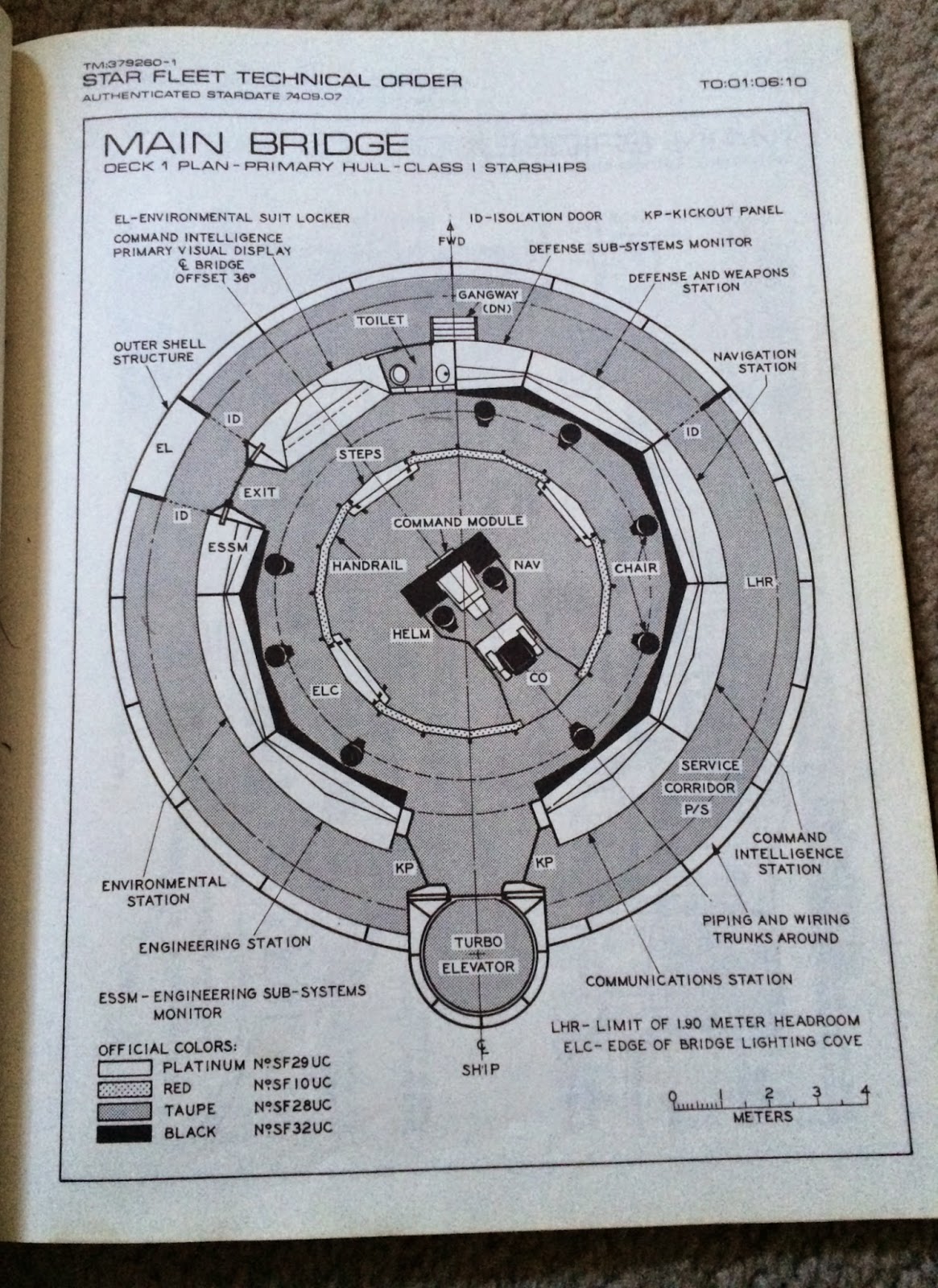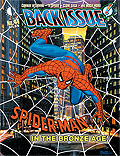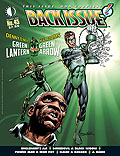Star Fleet Technical Manual (1975, Franz Joseph Designs, published by Ballantine Books)
Karen: Boy oh boy, was this buried treasure read cover to cover and ogled over and over! It's in
pretty bad shape today, which is why I had to take photos of the pages rather than put it on the scanner (the poor thing would have fallen apart) but that just shows how much it was loved. This is a first printing of a book that has been reprinted over and over again. It's famous among Trek fans for providing a look into the world of Star Fleet that went far beyond what we had seen on the TV show (and in 1975, all we had was the original series and the cartoon show, as well as a few novels). The great thing about this manual is that it is composed entirely as if it were in the world of the Federation; there are no references to "Star Trek" or the show. It's as if you are an officer in Star Fleet and have picked up your manual, with the relevant information you need to do your job.
Karen: One thing to remember is, that while we are inundated with Star Trek product today, in 1975, you really didn't have that much stuff available to speak of. Yes, there were some models and a few other things, but nothing like today, when you have Star Trek pizza cutters and bath mats. I mean, you could have Star Trek stuff in every room of your house if you wanted to now. And as for reading material, the James Blish novelizations of the TV shows, and "Spock Must Die", were about it. Stephen Whitfield's great "Making of Star Trek" was still two years away. So when the Star Fleet Manual came out, it was truly mind-blowing.
Karen: The technical manual was the brain child of fan Franz Joseph Schnaubelt, who sent some of his technical drawings to Lincoln Enterprises, Trek's merchandising arm at the time, and they were enthusiastic about putting together a product. And what a product it was. Trek fans went bananas and the manual sold like hot cakes, opening the doors for the flood of books, blueprints, and maps to come.Besides Joseph, there are many names recognizable to fans of classic Star Trek mentioned in the acknowledgements including Bob Justman, Walter Jeffries, Bjo Trimble, Irv Feinberg, William Thiess, Judy Lynn Del Ray, Stephen Whitfield, and of course, Gene Roddenberry.
Karen: So what's in the manual? Well, a little bit of everything. It starts off with two memos: one from the United States Military command, about the strange "data sheets" found in the Omaha Air Force Base computers. The second memo is from Star Fleet Command, and refers to a Captain Kirk and Lieutenant Commander Spock and their accidental trip back in time to that military base, and the accidental transmission of documents to the air base's computer. This is a reference to the episode "Assignment Earth," when the crew traveled back to the late 1960s. So we have an explanation for how we came by this manual.
Karen: The first section of the manual is very text heavy, including the Articles of Federation,which looks a lot like the US Constitution: "We the intelligent life forms of the United Federation of Planets..." This is a very thorough document covering the organizational structure of the Federation.There's also two peace treaties, one between the Feds and the Romulans, and one between the Feds and the Klingons. I have to admit, this was the section I looked at the least as a kid.
Karen: Next up: Banners! Every star system has its own flag/banner. The UFP has their own, 40 Eridani, Epsilon Indii, Alpha Centauri -all the different Federation members. Next is a uniform color guide (the only color page in the book). I remember wondering how to pronounce "Tenne," a golden color. (It's tenny, by the way.)
Karen: The next section probably got the most attention from me -the Command section. Here, we see insignias, uniforms, and best of all, starships! The insignias, which always appeared on the left breast of the uniforms, were nearly impossible to make out on the show. Now, thanks to the manual, we knew that the command branch wore a small star, the science branch had a stylized circle, and the engineering branch had a symbol similar to an 'e'. The braid that designated rank was also shown, making costuming much easier for fans as well. But the real treat of this section was the ships. On the show, the only Star fleet ships we saw were heavy cruisers like the Enterprise, almost certainly in an effort to save money. But here, besides the familiar heavy cruiser, we get three variations: the destroyer/scout, the transport/tug, and the dreadnought.While all variations on a theme, they seem like logical members of the same fleet. I recall at the time wishing I could get model kits of these ships, to hang up in my room alongside my Enterprise and Klingon cruiser. What's even more fun is the lists of the ships in each class. There are scores of ships listed, giving one visions of a huge fleet.
Karen: There are more diagrams, for the shuttlecraft, the typical stateroom on a cruiser (didn't you wonder where the bathroom was in Capt. Kirk's quarters?), and more importantly, the bridge of a heavy cruiser. If you wondered what each station was on the Enterprise, wonder no more. Now you could tell the Communications station from the Defense Sub-Systems Monitor. Important stuff, if you were going to serve on a starship. The command section was rounded out with schematics of the two versions of the phaser.
Karen: The Science section looks at the bridge science station, the tricorder, the galactic coordinate system, some warp drive calculations, and medical instruments. All good stuff, but not quite as exciting as starships!
Karen: The Support Services section examines the Communications bridge station, the communicator, and the Engineering deck, warp engines, and transporters, including some versions never seen on the show. To round the book out, illustrations are included of Spock's Vulcan harp and the three-dimensional chess set over which Kirk and Spock sometimes enjoyed a friendly game. There are also blank graph pages at the end of the book for adding more information -which this young Trek fan did!
Karen: I still enjoy looking at the manual today. It seems rather simplistic now, compared to all the books that have come out since, but it has a charm all its own, and knowing that it was the book that started it all gives it a special status in my heart.
Karen: The Support Services section examines the Communications bridge station, the communicator, and the Engineering deck, warp engines, and transporters, including some versions never seen on the show. To round the book out, illustrations are included of Spock's Vulcan harp and the three-dimensional chess set over which Kirk and Spock sometimes enjoyed a friendly game. There are also blank graph pages at the end of the book for adding more information -which this young Trek fan did!
Karen: I still enjoy looking at the manual today. It seems rather simplistic now, compared to all the books that have come out since, but it has a charm all its own, and knowing that it was the book that started it all gives it a special status in my heart.



























































11 comments:
Never had this personally, but I remember flipping through an updated edition a few times in bookstores when I was in high school (in the early/mid-'80s). I recall being impressed with the detail and the care and craft that went into making it, so that it was all internally consistent.
And I always thought it was so funny that the bridge's toilet is right next to the main view screen...
By the way, Karen, the edition(s) I remember examining (seriously, I would spend about a half hour to 45 minutes in the bookstores with these - surprised I didn't get dirty looks from the clerks) had, besides those Federation member banners, images of the home planets with some basic geographic facts listed. Was that the case for this one you have? That aspect fascinated me in particular.
Otherwise, I have to say the Star Fleet manual always makes me think of Galaxy Quest, when all of the hard-core geek fans who memorized the technical specs for the ship help save the day.
There. Stepped away a moment to pluck mine off my book shelf. Damnation, still in pretty decent shape for something 39 years old. First printing and everything. According to the Inflation Calculator, the $6.95 price tag would be like dropping $31.00 today.
I can add little but a hearty "Affirmative" to your analysis, Karen. Though, in 1975 and now today, I find the "Articles of the Federation" to be nothing but boring filler.
As Edo suggests, with the uniform pattern instructions and all the detailed measurements of phasers and tricorders, this is the "Blueprint for the Well-Dressed Trekkie" more than anything.
Oh yes. Looking at the Bridge blueprint, I recall getting a frownie face when I first read it. It is too detailed. It makes much more sense than what we actually saw in the show. There are a couple-three plots where the Bad Guy has locked down the turbo-elevators and the bridge crew is gassed or something. Yet, the blueprints show they could, maybe, use the "Exit" and leave via the service corridor.
And it was a nice bit of luck that Captain Kirk wasn't facing down some alien thing on the main screen just as Ensign Leibowitz came out with a flushing sound, checking his zipper.
This was the book that started me on a lifelong usage of "stardate". Since this book (and subsequent Trek calendars), I've always notated the date as 1409.17 (for example).
Cheers! Live long and prosper!
I say everybody hit Conn's this weekend, we get as much cardboard as we can and make our own Bridge. It would be AWESOME!!!!
I do wonder if the same rule for bus travel applies to space travel. No number 2. I mean, like Murray was saying, if you have to leave the fan on, who turns it off? Do you go back? Or is it now the problem of the next guy? I bet that's how they lost their first red shirt.
The Prowler (started this post with a demerit).
This was definitely one of the first 'of it's kind' of fan publications, acutally bound and not in some cheap magazine format. The publishers were obviously tracking the healthy sales of all those paperbacks, and the growing grassroots attendance at Trek conventions.
One correction, the 'Making of' book was originally published in 1968 (I'm still trying to get the first cover edition off eBay in decent condtion, without spending a mint..), and had several reprintings with different covers. So it's been out for 7-8 years already. (It's also why it only had the first 2yrs of episodes, not the third year).
I also found this tech manual far more interesting than the previously published 'Blueprints'. My friend and the blueprints, but sold it to someone to by this book. My copy actually had 4-5 cover 'inserts' for the front cover sleeve, so I gave one or two away to friends.
Like Karen, I lived and breathed this book for a couple of years. With the AMT models, this was a Trekker's dream. I'd had wished it had some mention of Klingon/Romulan designs since they were established enemies, but just having the schematics of the shuttlecraft, bridge (so THAT'S where the bathroom was...), and other key locations were uber-cool. And yes, those Articles were a few pages of snore-ville.
And like Karen said, the best part was that it had NO mention of Trek 'the series'. It was very much like a 'standard StarFleet issue' manual.
'What Trekker could want more..?'
Great column.
Man, I sure had a deprived childhood.
One small correction, if I am not mistaken— the events that placed this manual into the hands of the 20th Century U.S. Air Force security occurred in D.C. Fontana’s “Tomorrow Is Yesterday.”
I loved this manual’s attention to detail and trivia, but IIRC a lot of it was fairly self-referential and redundant as well. Early Star Wars stuff was similarly impoverished.
Geez, Pat , you are absolutely correct. I guess my mental library computer had a glitch and I forgot which episode it was. Serves me right for relying on memory alone! Thanks for the correction.
David, for the Whitfield book I consulted online sources, not my own well-worn copy to get the publishing date. But you are correct, and my sources were wrong. Actually the copy I have is a later version as well. So I apologize for the errors today folks. I hope you still get a kick out of the pictures!
Did anyone grab any of the later manuals? I had the officers manual that was made after ST:TMP came out -it may have been fan-produced; it certainly was not as sleek as this manual. I also had the medical manual, and much later, Mr. Scott's Guide to the Enterprise. That last one was pretty nice.
The Seventies were certainly lean years for Trek fans.Never owned the manual but I did buy Whitfield's Making of Star Trek which I read over and over and over - still have my copy, though the pages are yellowed and the photo sections have come unglued from the binding. It was a terrific book giving insights into how a TV show came into being.
I never had this, but I've seen it around a few times. I love reference manuals like this (which is why I loved the Marvel Universe/Who's Who books so much); I especially love the Star Charts, since I'm such a map geek. Plus, they actually had a section on navigation, which I found fascinating...although I had to read a pre-calc book to get the gist of some of the math :)
Speaking of Who's Who, I recall DC publishing "Who's Who in Star Trek", but I never got those since I didn't read Star Trek comics; I'm not sure if it covered stuff from the show/movies or not.
Mike W.
As for tech manuals/schematics, I became a huge fan of those Star Trek Magazine issues in the '90s that had all the different bridges, sections, layouts of weapons, shuttles, uniforms, etc.., plus interviews, etc. It was very high-end (and expensive..), but each issue had great pullout posters of all the different Trek franchise entries, from TOS to Voyager (not sure about 'Enterprise'..).
Again, fairly expensive magazines, but they were pretty cool to pick up.
Still, today's technical manual was clearly a decade ahead of it's time and a pretty phenominal gamble considering it's based solely off the affiliate's rerun (and local fan convention) success of an oft-considered failed show. Kudos to Ballantine Books who obviously made a mint off these from all the grass-roots Trek fans back in the day, and drove others to issue similar bound books later for Star Wars, Galactica, etc.
"I Grok Spock", indeed.
I want this! Dammit Jim I'm a doctor not a technical draftsman! Seriously, though, this manual must have seemed like the Holy Grail to hardcore Trekkies when it first came out. I never had this but just looking at those specs on the different starship classifications brings out my inner Scotty!
As for the toilet being right next to the main screen, hmmm ... wonder if Kirk took a leak, zipped up his fly, then said 'Fire photon torpedoes! Take that, Khan!' :) On a related note, I remember George Takei saying in an interview after ST: the Motion Picture came out that whoever designed the costumes for that movie failed to take into account the biological needs of the actors. Apparently, the costumes were hard to remove. Whenever cameras weren't rolling, according to him, you would see grown men running around trying to find the nearest toilet!
- Mike 'which page has the instructions to build a phaser?' from Trinidad & Tobago.
Post a Comment